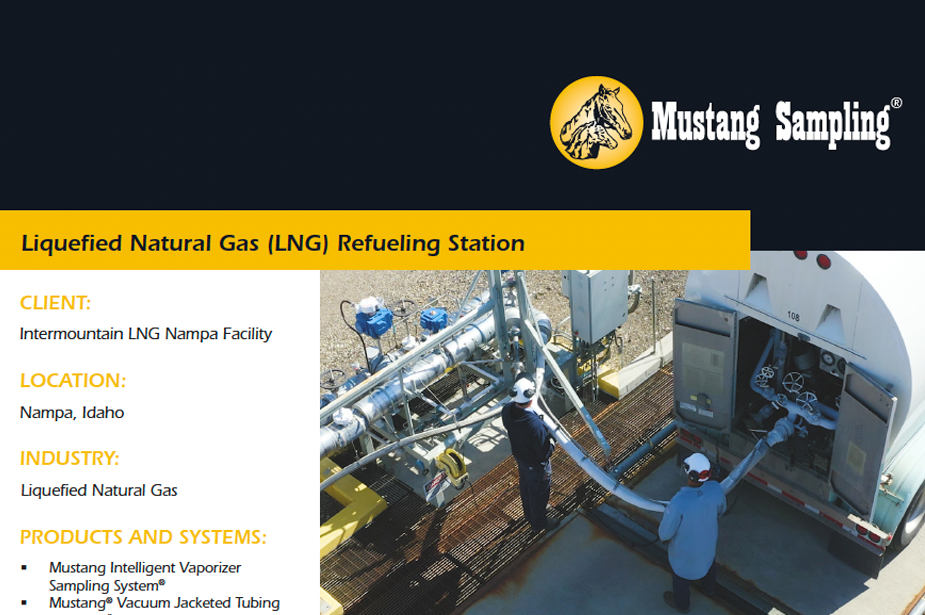CLIENT:
Intermountain LNG Nampa Facility
LOCATION:
Nampa, Idaho
INDUSTRY:
Liquefied Natural Gas
PRODUCTS AND SYSTEMS:
- Mustang Intelligent Vaporizer Sampling System®
- Mustang® Vacuum Jacketed Tubing
- SoftView® LNG Monitor
- Pony® Heated Probe Enclosure
- Mustang® P53® Sample Conditioning System
- Gas Chromatograph
THE BACKGROUND
Intermountain Gas Company is the sole distributor of natural gas in Southern Idaho. Its service area extends across the entire breadth of Southern Idaho, an area of 50,000 square miles, with a population of approximately 1,260,000. During the fiscal year of 2016, Intermountain served an average of 345,000 customers in 74 communities through a system of over 12,000 miles of transmission, distribution and service lines. Over 169 miles of distribution and service lines were added during 2016 to accommodate new customer additions and maintain service for Intermountain’s growing customer base. Designed as a Peak Shaving facility in 1974, the Intermountain Gas Company’s LNG facility in Nampa, Idaho, provides additional gas supply to the growing community and serves as a merchant hub for LNG distribution.
Intermountain’s customer base is expected to continue growing through the next decade. Natural gas is the cleanest burning fossil fuel, and according to the US Department of Energy, Liquefied Natural Gas is considered safer than other commonly used hydrocarbons due to its unique physical and chemical properties. It will not burn in its liquid state, and it evaporates rapidly. Resulting vapors leave no residue on water or soil, and such vapors are only flammable within a narrow range of gas-air mixture. As such, LNG is desirable for a number of industries including peak-shaving, base load, and transportation fuel, and the demand for LNG is increasing year over year. Currently averaging 600,000 gallons a month in LNG sales, with trucks going to locations in Utah, Idaho, Oregon, Washington and Nevada, Intermountain requires all parts of its facility to run effectively and reliably.
THEIR CHALLENGE
Since 2011, the Intermountain facility has been filling trucks for transport with LNG daily. As the cleanest burning available fuel source, numerous companies are choosing to fuel with LNG. The Intermountain facility also supplies Glanbia Whey with LNG as an alternative to propane as part of their sustainability program, along with a fleets of mining and other heavy duty trucks that are traditionally powered by diesel fuel. The surplus of liquefied natural gas at the plant propagated the transformation from a peak shaving facility into a distribution center to accommodate current utility customers as well as nonutility customers. Intermountain’s biggest challenge was to maximize the facility while maintaining peak use capability for sale service customers. This meant on-line monitoring equipment installed detecting oxygen, moisture, hydrogen sulfide (H2S) and BTU’s, additional safety and quality control of the LNG coming in and out of the facility as well as meeting any new DOT, State or PUC regulations on LNG resale to utility and nonutility customers.
THE MUSTANG SAMPLING SOLUTION
Gas arriving at the Intermountain facility requires a liquefaction process to convert to LNG. The gas is processed to clean it, separating it from water, impurities and other associated liquids. Prior to the cleaning process samples are extracted from the natural gas pipeline via a Pony® heated probe enclosure, prepped by a Mustang® P53® Sample Conditioning System then sent to a Gas Chromatograph for analyzation. Once the sample verifies that the gas meets Intermountain’s quality standards the natural gas is converted to LNG.
The conversion of natural gas to LNG begins with the separation of lighter from heavier components. Other impurities are also removed, mainly water, carbon dioxide, and hydrogen sulfide, all of which may block the process at lower temperatures. Propane and butane are extracted to be from the stream to either be sold separately or used at a later stage of cooling. Trace amounts of mercury are removed and the remaining gas stream of methane, ethane, and nitrogen are ready for liquefaction. As the gas proceeds through stages of heat exchangers, the coolant chills the gas to about -270°F, shrinking the volume by nearly 600 times, and creating a clear, colorless, non-toxic LNG product.
Mustang Sampling provided a Mustang Intelligent Vaporizer Sampling System®, Mustang Sampling’s SoftView® LNG Monitor Software and a Gas Chromatograph for the plant to monitor not only the LNG Intermountain was processing, but also what it was selling and storing. Since 2012, the equipment has been running steadily while loading numerous trucks a day, 365 days a year. The SoftView LNG software specifically designed for Liquefied Natural Gas applications, in this case loading trucks with LNG, collects and records gas composition and vaporizer diagnostic information every two minutes for the entire period of time the truck is being loaded.
At the conclusion of the loading event the software produces a report that includes Methane, Ethane levels, BTU (caloric value) plus an average of all the composition data collected, as well as other pertinent information such as inlet and outlet pressure, to ensure the quality of the LNG for both Intermountain, and the receiving customer.
With the near constant nature at which the Nampa facility operates reliability is key. The Intermountain facility has been capable of loading up to six trucks a day Monday through Friday without any issues concerning implemented systems.
This functionality became even more useful when Intermountain approached the public utilities commission about a inquiries from potential customers in relation to surplus LNG at the Nampa facility. The commission approved the service, allowing Intermountain to maximize the facility while maintaining peak-use capability for sale service customers. Now the facility’s off-loading capabilities will continue benefiting the utility’s standard service customers while also being used to sell LNG to non-utility customers such as heavy duty trucks and fleet vehicles.


